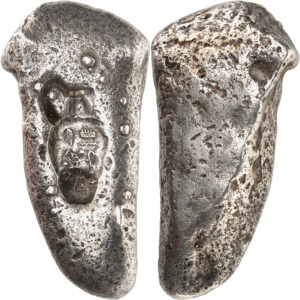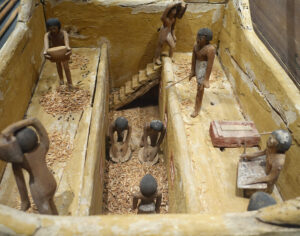On 18 November 2019, auction house Numismatica Genevensis SA in Geneva will offer an object – No. 101 – that will dispute our version of monetary history. The object in question is a silver bar with a cartouche bearing the name of Pharaoh Tutankhamun. This bar has the weight of half a deben which means it was issued in a weight unit corresponding to the currency of account in ancient Egypt. So, do we have to predate the beginning of coinage by more than half a millennium? Were ancient pharaohs already familiar with the concept of “coins”?

The Object
The object on offer is a drop-shaped bar made of high-quality silver. The silver content of 98.54% indicates that the material is artificially refined silver and presents the highest grade of fineness a goldsmith was able to achieve back then.
Its weight of 41.55 g differs by 8.7% from 45.5 g – which would be the weight of half a deben or 5 kites. Such a deviation is quite acceptable, as we know from other numismatic epochs.
The cartouche in the form of a jug bears the name of Pharaoh Tutankhamun and calls him ruler of Heliopolis in Upper Egypt. The inscription supplies us with a date: Tutankhamun reigned between 1345 and 1327 BC.
The bar offered at Numismatica Genevensis SA is one of two pieces from the collection of Roger Pereire, who died already in 1968. His daughter sold her father’s collection at the beginning of the 70s. Since then, the silver bar has been part of a Swiss private collection.
The Egyptian Currency System
Actually, it should not come as a surprise that such silver bars with the function of a coin do exist. We know that standardized bars have existed since the Bronze Age. Bars made of bronze were certainly traded as standard pieces of raw material. Perhaps they were even used as a form of primitive money. If we remember that the Egyptians – just like the inhabitants of Mesopotamia – had a highly differentiated economy and a complex accounting system used constantly in the daily economic life, a silver bar of the same currency system – which might have been used as a means of payment – will perfectly fit into the picture.
Prices of everyday goods, wages and units of account, which were used to calculate the former two, are written on hundreds of ostraka from the workers’ village on the West Bank of Thebes. Craftsmen and merchants of the New Kingdom calculated in silver, copper and grains – depending on the value of the good. Larger sums were expressed in silver, everyday sums in copper and small amounts in grains. In very rare cases, the price was even indicated in debens of gold. In addition to debens of silver, also shenati of silver were used on the West Bank of Thebes – these units were worth at first 5 and later 4 debens of copper.

Twenty Pieces of Silver for the Slave Joseph
Let us have a look at some practical examples. A tax inventory made on order of Ramses III (1188–1156) mentions, among other things, the income accrued in copper (26,320 debens), linen (3,722 debens), incense, honey and oil (a total of 1,047 debens), grains (309,950 debens), flax (64,000 debens) and waterfowls (289,530 debens).
A bill to Erenofre, a lady of a house who bought a female slave, proves that ordinary people used debens and kites for their calculations, too. The cost amounted to 5 debens of silver. She made use of the content of her linen cupboard in order to get the money together and gave the merchant a blanket of Upper Egyptian cloth worth 3 1/3 kites of silver, a djayt garment of Upper Egyptian cloth worth 4 kites of silver, a dress of fine Upper Egyptian cloth worth 5 kites of silver and several further objects until the amount of 5 debens of silver was paid.
The step from such a sophisticated accounting system to small silver bars worth half a deben is quite small. And actually, this would make a story that has been known to us for centuries appear in a completely new light – at least in terms of its significance for monetary history: The book of Genesis (Gen 37.28) describes how Joseph was sold to Midianites merchantmen. 20 pieces of silver changed hands. Until now, we interpreted them as pieces of raw silver, which were weighed after handing them over. However, if that was correct, wouldn’t it have been more logical to speak of their weight instead of their number? And considering that the Egyptian woman paid five debens for the young female slave, these silver pieces could well have been small bars worth half a deben. Relations of price are quite stable. So, when the Edict on Maximum Prices of Diocletian was written, the value of male slaves still was 30 to 50% higher than the value of female slaves – therefore, the price of 10 debens of silver for a strong male slave would be quite realistic.
A Thief Stole a Sack Full of Pieces of Silver
Another text confirms this picture. It reports a theft: A man stole a vessel made of gold at five debens, four jugs made of silver weighing twenty debens and a small sack of silver bars at eleven debens.
Are There No Similar Pieces or Have They Simply Not Been Taken into Account Yet?
Until now, the numismatic world does not know about similar pieces – however, this does not necessarily mean that they do not exist. Their significance might not have been recognised by the scholars yet because they are rather inconspicuous objects – at least in the view of an Egyptologist. However, treasures containing bars made of gold and silver have been found. For example, the treasure from the Temple of El Tod, which was divided between the Louvre and the Egyptian Museum in Cairo, included silver bars with a total weight of 8.87 kg. Perhaps they match the Egyptian weight standard, too.
A New Picture of Monetary History
The bar offered at Numismatica Genevensis SA is a significant indication that minting small bars on the basis of a widespread accounting system that were guaranteed by the mark of a die was no Lydian-Greek invention.
And this would fit perfectly to our knowledge about how the Greek culture made use of foreign innovations in order to develop concepts suitable for everyday use.
For even though this spectacular bar might have laid the foundation of a working coinage system, the Greeks made this idea suitable for daily use.
Literature:
Manfred Gutgesell, Arbeiter und Pharaonen. Wirtschafts- und Sozialgeschichte im Alten Ägypten. Hildesheim 1989.
David M. Schaps, The Invention of Coinage and the Monetization of Ancient Greece. Ann Arbor 2007.
Michel Valloggia, Note sur deux lingot d’argent de Toutânkhamon, Revue d’égyptologie 68 (2017-2018), pp. 141–152.
Here you can visit the website of Numismatica Genevensis.






